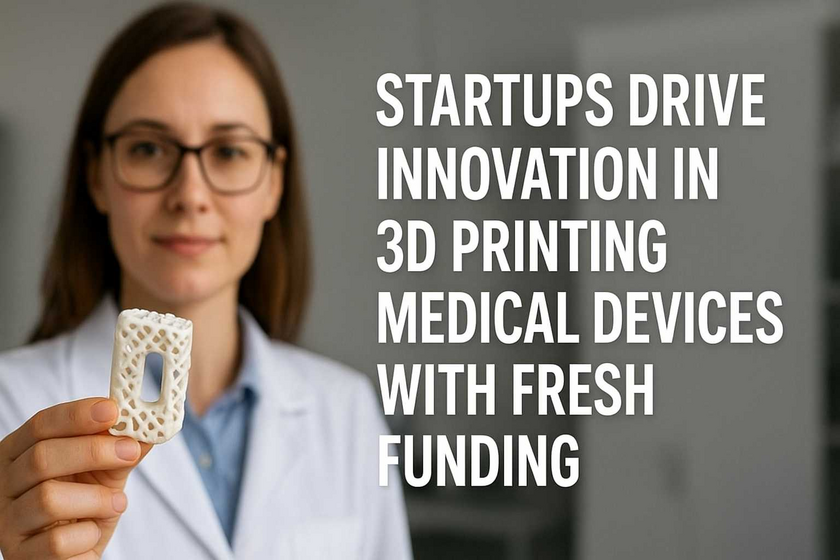A new wave of startups is revolutionizing the medical device industry, leveraging groundbreaking 3D printing technologies to create patient-specific implants, prosthetics, and even living tissues. Bolstered by recent, significant funding rounds, these agile companies are accelerating the adoption of personalized healthcare solutions and pushing the boundaries of what's medically possible.
The global 3D printing medical devices market is experiencing explosive growth, driven by this surge in innovation. According to SNS Insider, the market was valued at USD 2.69 billion in 2023 and is projected to reach a staggering USD 11.46 billion by 2032, growing at a compound annual growth rate (CAGR) of 17.49% from 2024 to 2032. This growth trajectory underscores a major shift in healthcare towards customized patient care.
"The growing usage of 3D printers and bioprinters provides healthcare providers with tools for producing customized solutions tailored to the individual patient, enhancing the effectiveness of treatments and recovery times," notes a recent market analysis. This capability for personalization is a key factor propelling the market forward.
Startup Funding Gains Momentum Worldwide
Recent funding rounds highlight the growing investor confidence in 3D printing medical device startups. Across the globe, venture capital firms and strategic investors are placing bets on companies with promising technologies that could disrupt traditional medical manufacturing.
Brinter, a startup with operations in North Carolina and Finland, recently secured $750,000 in a seed funding round as part of a total funding package of $2.2 million. The company develops modular, multi-material 3D bioprinters capable of producing implants designed to restore damaged body parts. Their technology enables a personalized medicine approach using patients' own cells and the body's natural repair mechanisms.
Similarly, VoxCell BioInnovation, based in Victoria, Canada, raised $1.7 million in seed funding to advance its high-resolution 3D bioprinting technology. The company specializes in creating vascularized cancer tissue models that provide more accurate testing platforms for drug development and oncology research. Their technology aims to bridge the gap between laboratory data and clinical trials, potentially reducing both the time and costs associated with pharmaceutical development.
Nottingham-based 4D Biomaterials has also joined the funding wave, raising $2.1 million to commercialize its unique resorbable biomaterials for medical applications. The company's patented 4Degra® materials degrade differently from conventional biomaterials—breaking down gradually from the surface inward rather than collapsing unpredictably from the inside out. This controlled surface erosion releases byproducts slowly at lower concentrations, significantly improving safety profiles for medical implants.
Startup Innovations Span Multiple Medical Specialties
The current landscape of 3D printing medical device startups reveals a diverse array of technological approaches targeting different healthcare challenges:
· Next Big Innovation Labs (Karnataka, India) is tackling the global organ shortage by developing 3D bioprinters called Trivima and working on 3D bioprinted human skin known as Innoskin®️. The company's long-term vision involves creating a versatile 3D bioprinting platform that combines patented technologies, multidisciplinary expertise, and breakthrough biomaterials.
· SPEBIO (Pohang, South Korea) has developed a platform technology that uses 3D bioprinting to enable cell aggregation, producing cell spheroids, aggregates, or clusters. These structures can generate extracellular vesicles and therapeutic agents derived from aggregated cells, with applications in organ transplantation, drug testing, and disease modeling.
· TeVido Biodevices (United States) focuses on applications for reconstructive and cosmetic surgeries, particularly for breast cancer survivors. The company uses patients' own melanocytes during the 3D printing process to reduce the chance of rejection, offering treatments such as nipple reconstruction and cell therapy for vitiligo patients.
· CELLINK, now part of the BICO Group, continues to innovate after being the first company to release universal bioink in 2016. The company is currently focusing on automation in 3D bioprinting workflows to improve scalability for clinical applications, playing a crucial role in turning 3D bioprinting into a multi-billion-dollar industry.
· AesculaTech (Los Angeles, USA), a Y Combinator-backed startup, has developed AesculaGel, a platform technology that offers adaptive response to a wide range of stimuli. Their cornerstone product, Humidifeye, is an ophthalmic platform designed to treat dry eye disease, which affects more than 25 million Americans. The company has also received a National Science Foundation I-Corps grant, further validating its innovative approach.
Market Context and Growth Projections
SNS Insider's analysis provides a comprehensive outlook on the forces shaping the 3D printing medical devices sector. The market's expansion is primarily fueled by the rising demand for personalized medicine, the increasing number of minimally invasive procedures, and the pursuit of higher-performance medical outcomes. Technological advancements are enabling the production of complex anatomical models, biocompatible implants, and precise surgical guides, which are finding increasing applications in orthopedic, dental, and craniomaxillofacial surgeries.
A key trend identified is the rising demand for tissue engineering and bio-printing, which is driving the development of more sophisticated products. The growing usage of 3D printers and bioprinters is equipping healthcare providers with the tools necessary to produce solutions tailored to individual patient anatomy, significantly improving treatment efficacy and reducing recovery periods.
A Market Segmented for Growth
The dynamism of the 3D printing medical devices market is reflected in its diverse segments, each showing unique growth patterns:
· By Component: 3D printers themselves form the largest and most significant segment, holding approximately 40% of the market share in 2023. Meanwhile, 3D bioprinters represent the fastest-growing category, driven by breakthroughs in regenerative medicine and tissue engineering.
· By Application: Surgical guides led the market in 2023, accounting for a 35% share. Among these, orthopedic guides are experiencing the most rapid growth, fueled by an increasing number of joint replacement and other complex orthopedic surgeries that benefit from patient-specific precision.
· By End-User: Hospitals and surgical centers are the dominant end-users, a trend driven by the increasing affordability of 3D printing services and the rise of in-house 3D printing labs that allow for rapid, on-demand device production.
Regional Leaders and Future Hotspots
From a regional perspective, North America dominated the global market in 2023. This leadership is attributed to the presence of key market players, advanced healthcare infrastructure, and substantial investments in research and development. Supportive regulatory frameworks, particularly from the U.S. Food and Drug Administration (FDA), have also been crucial in fostering innovation.
However, the Asia-Pacific region is emerging as a key growth area. Driven by increased healthcare investments and the rapid adoption of 3D printing technology in emerging economies like China and India, the region is expected to grow at a rapid pace. Modernization of healthcare infrastructure and a growing demand for customized medical solutions are creating a fertile ground for market expansion.
The Road Ahead
The future of 3D printing in medicine is exceptionally promising, extending far beyond static implants. The industry is moving towards the development of bioresorbable implants that dissolve safely in the body after healing and hybrid devices that combine multiple materials and functions. The potential for on-demand printing in remote healthcare settings could also revolutionize access to critical medical devices worldwide.
As startups continue to break new ground with the support of fresh funding, and as regulatory pathways become more defined, 3D printing is poised to move from an innovative tool to a standard of care, making personalized, high-precision medical devices accessible to a much broader patient population.


















